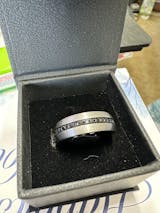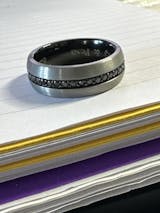
When you're shopping for the perfect ring, whether it be a wedding band or a stylish accessory, the choice of metal is a crucial decision. Tungsten and titanium are two popular materials for modern rings, especially for men. Both materials offer a unique combination of strength, durability, and style, but there are distinct differences between them that you should consider before making your purchase.
Tungsten, a rare metal on Earth, is known for its impressive density and scratch resistance. In fact, it's about 90% heavier than steel and similar to gold in terms of weight. This makes tungsten rings incredibly durable and less prone to bending or denting. On the other hand, titanium's density is 43% less than steel, making it lighter and more comfortable to wear. However, its lower hardness rating means it is more likely to show signs of wear over time.
Both tungsten and titanium rings have unique properties that make them attractive choices for jewelry, but they also share one notable downside: their strength and hardness make them difficult to resize. So, it's essential to be sure of your ring size before committing to either metal. Consider the durability, weight, and comfort of each material as you explore your options, ensuring you end up with a ring that suits your preferences and lasts a lifetime.
Key Differences and Similarities
Hardness and Durability
Titanium and tungsten are both known for their hardness and durability. Titanium has a rating of 6 on the Mohs scale, while tungsten is much harder, with a rating of 9. This means tungsten rings are more resistant to scratches and wear compared to titanium rings. However, both materials are significantly more durable than traditional metals like gold or silver.
Color and Appearance
In terms of color, titanium has a slightly darker shade of gray compared to steel, while tungsten is even darker and can have a gunmetal hue. Both metals can be polished to a high shine or given a brushed or matte finish. As for appearance, titanium offers a lighter, more casual look, whereas tungsten gives off a more substantial and luxurious feel.
Scratch Resistance and Maintenance
Tungsten has an edge over titanium when it comes to scratch resistance due to its higher hardness rating. This makes tungsten rings a low-maintenance option that will retain their appearance longer. However, both tungsten and titanium rings are easy to clean and maintain, requiring only occasional polishing to maintain their shine.
Weight and Density
One of the key differences between titanium and tungsten rings is their weight and density. Titanium is much lighter, with a density that is 43% less than steel. In contrast, tungsten is 90% heavier and has a density similar to gold. This means that titanium rings will feel lighter on your finger, while tungsten rings have a more substantial and weighty feel.
Cost and Affordability
When it comes to cost, titanium and tungsten rings are generally more affordable than traditional precious metals like gold and platinum. The price of titanium and tungsten rings can vary depending on the design and craftsmanship, but both options are typically budget-friendly for most consumers.
Wedding Bands and Rings
Both titanium and tungsten are popular choices for wedding bands and rings due to their durability, affordability, and range of styles. They're also hypoallergenic, making them suitable for those with metal allergies. However, it's worth noting that neither material can be easily resized, so it's crucial to ensure the correct sizing when purchasing a ring.
Design and Craftsmanship
Titanium and tungsten rings are available in various designs, including simple bands, intricate patterns, and even inlaid with other materials like wood or carbon fiber. Due to their hardness, both metals require specialized tools and techniques for crafting, which can result in unique and eye-catching designs.
Allergenicity and Biocompatibility
Both titanium and tungsten are hypoallergenic and biocompatible materials, making them ideal choices for individuals with metal allergies or sensitive skin. This is particularly crucial when selecting a wedding band or ring that you'll be wearing daily, as you want to ensure the material won't cause any adverse reactions.
Advantages and Disadvantages
When choosing between tungsten and titanium rings, it's essential to consider the pros and cons of each material. Let's dive into some of the key advantages and disadvantages.
Tungsten:
Advantages:
-
Scratch-resistance: Tungsten is known for its incredible scratch-resistance, making it an excellent option for those who want to maintain the ring's appearance over time.
-
Density: Tungsten is denser than titanium, contributing to its durability. It's less likely to bend or dent as a result.
Disadvantages:
-
Brittleness: Despite its durability, tungsten can be quite brittle. If dropped, a tungsten ring could shatter, similar to glass.
-
Weight: Due to its higher density, tungsten rings are often heavier compared to titanium rings, which might not be comfortable for some wearers.
Titanium:
Advantages:
-
Lightweight: Titanium rings are generally lighter than their tungsten counterparts, offering more comfort for daily wear.
-
Corrosion-resistant: One of the benefits of titanium is its resistance to corrosion. It remains untarnished when exposed to various elements, such as water and air.
Disadvantages:
-
Scratch-resistance: While titanium is still relatively scratch-resistant, it's not as strong as tungsten in this regard. Over time, titanium rings may show more signs of wear
-
Deformation: Titanium is a softer metal compared to tungsten. If subjected to significant pressure, titanium can become deformed or bent.

Frequently Asked Questions
What are the main differences between tungsten and titanium rings?
Tungsten and titanium rings are both popular materials for contemporary jewelry. While they might appear similar, their properties are quite different. Titanium is harder than gold and platinum, making it resistant to corrosion, tarnishing, breaking, and scratching. On the other hand, tungsten is a denser and heavier metal, which gives it a more substantial feel when worn. When under high pressure, tungsten shatters into many pieces, while titanium bends and becomes deformed.
Do tungsten and titanium rings have similar appearance and color?
Tungsten and titanium rings might look similar, but there are some differences in their appearances. While both are metallic, tungsten often has a brighter, shinier appearance, and titanium has a more subdued, matte finish. The color of titanium rings can vary slightly depending on the specific alloy used, whereas tungsten rings typically have a uniform, dark gray hue.
Can both tungsten and titanium rings be resized?
Resizing tungsten and titanium rings can be quite challenging. Because both ring types are very strong and hard, they're not suitable for any kind of resizing. Traditional resizing methods used for gold and silver rings don't apply to these materials. If you need a different size, it's usually necessary to purchase a new ring rather than attempting to resize the existing one.




